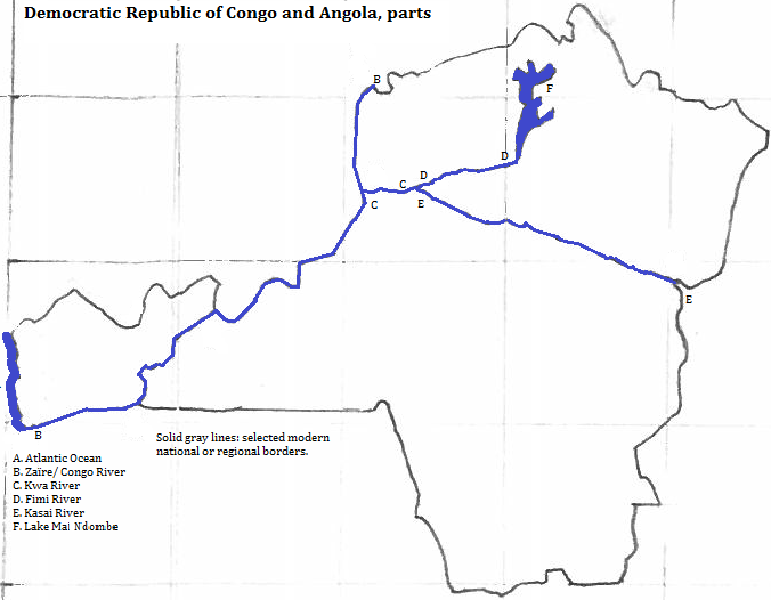
| To Duval Family Home Page | Africa | Democratic Republic of Congo |
| To Chris Home Page | To Earth (Geography Home Page) | Angola |
The 367 thousand square kilometers are comprised of two unequally-size geophysical zones: the coastal lowlands and the plateau that begins a short distance inland. Other than a few short coastal rivers in and near Cabinda, the entire region is drained by the Congo River. The river itself forms the area's northwest bound as far downstream as Livingstone Falls.
The Congo's chief tributary
Salonga National Park, a UNESCO World Hertitage Site, is partly in Bundundu Region.
Zongo Falls, a tourist attraction,

Around 20 million people lived here in 2006. There is no majority first language, although about six in ten speak languages in the H group of Central Narrow Bantu. The most important of these is Kongo (or Koongo
The B group of Northwest Central Bantu accounts for almost two in ten, including the Teke dialects, which themselves amount to almost one in ten.
Lingala, a non-local language, is the lingua franca in the capital, even though the majority there speak Kongo. Some learn French, an administrative language.
The overwhelming majority are Christians, most of them Roman Catholics, though some are Protestants and some Kimbanguists. A minority, fewer than the Kimbanguists or Protestants, follow traditional religions that emphasize place-centered and ancestral spirits, witches (hereditary magicians), sorcerers (non-hereditary) and diviners that assist in curing ills, bodily or other.
The Church of Jesus Christ on Earth by the Prophet Simon Kimbangu evolved from its founders teachings in the 1920s, and is very popular in the west of this area.
There is one very large metropolis, Kinshasa-Brazzaville, centered on the capital, Kinshasa. Tourists visit the city of Cabinda (population 378 thousand
Bantu speakers arrived from the north within the last 4,000 years. The Kongo language acquired its importance in the last 1,000 years, when it was the language of a kingdom south of the Congo River and of traders north of it. Lingala is an offshoot of Bangala, and originated to the northeast of this area.
Under Belgian rule, Lingala was favored by the colonials, and it spread widely as a second language, more so than the colonials' own language, French.
The Belgians, and their Portuguese predecessors, were much more successful in introducing Christianity than their language, and European and American missionaires furthered it. The Kimbangist Christians gained popular favor as anti-colonialists, and state favor under the dictator, Mobuto Sese Seko.
northwest
northeast
east
southeast
southwest
west
1. Formerly Zaïre. Also called Kinshasa Congo.
2. Bas in French.
3. Chutes in French.
4. The Congo is Africa's second longest river, the world's eighth; the Kasai is Africa's ninth or tenth longest river.
5. Lac in French.
6. http://www.tripadvisor.com/Attractions-g294187-Activities-Kinshasa.html, accessed 7/18/2015.
7. https://www.thecrazytourist.com/15-best-places-to-visit-in-angola/, accessed June 7, 2018.
8. The two dialects are São Salvador Kongo and Koongo.
9. https://en.wikipedia.org/wiki/List_of_cities_and_towns_in_Angola, accessed July 10, 2018.